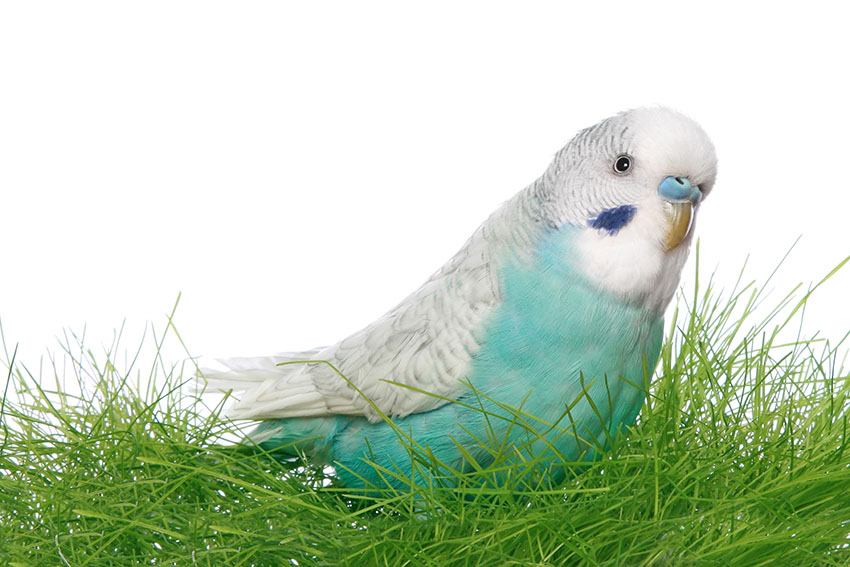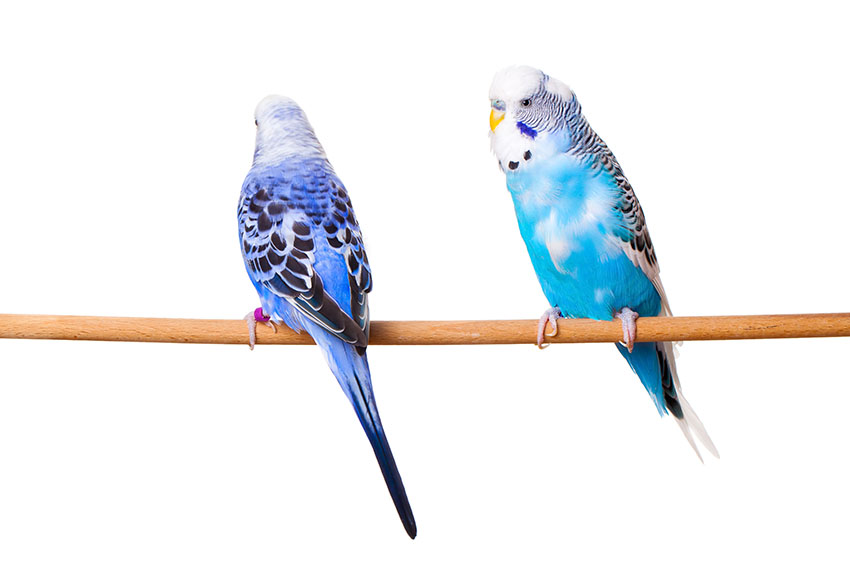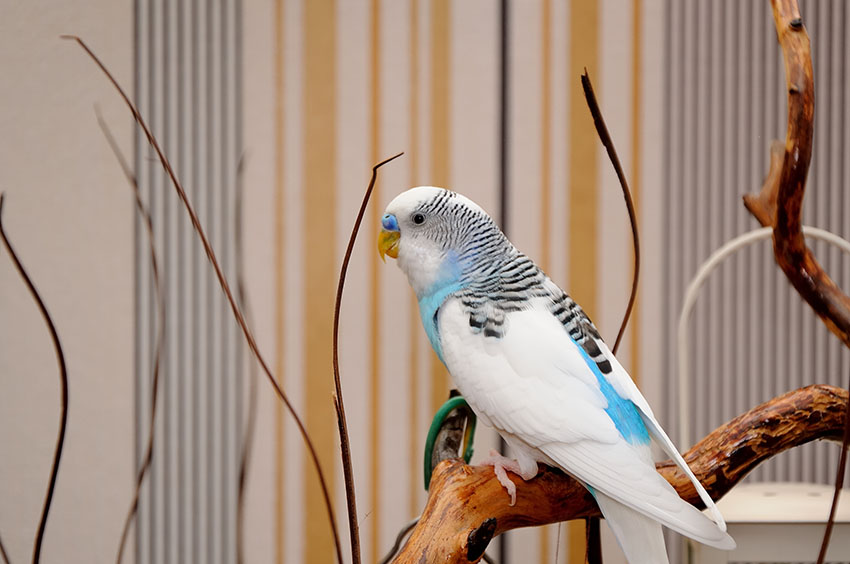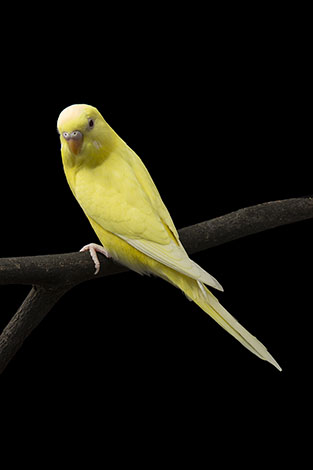What Are the Blue Dots on a Parakeet
In most budgies, the markings and patterns of their plumage are uniform, in spite of the different bird varieties. The 'normal' plumage colours are subject to changes, though, sometimes fading from browns and greys to nothing whatsoever. The broad categories here are Brown, Grey and Pied.
Brown Budgies
Some budgies have brown markings instead of black. This is part of an overall lightening of the bird's colours, as if it has bathed in chalk dust. This colouring does not belong to a distinct variety of budgie, but is one of many details that differentiate one bird from another. The commonest brown-patterned types are the Cinnamon, where the lightening effect is minimal; and the Fallow, which is much lighter than the Cinnamon. Fallows have red eyes and pink feet, and their beak and cere colours tend to differ from standard birds too.

Brown budgie 'Cinnamon' type
Paler still is the Lacewing. These birds are yellow or white, sometimes with just a faint hint of green or blue, and are the result of a bird carrying a Cinnamon gene, and an Albino or Lutino one (see below). Neither gene is dominant, enabling both factors to manifest in the bird.
Grey Budgies
Some budgies have grey markings instead of black. As with the brown varieties mentioned above, they have reduced colouring, lending them a ghostlike appearance when perched beside a non-grey bird. The Greywing type is very common, and has half the 'normal' budgie colour leached away. The Dilute type is even more pale, its ghostly chin spots making the bird's face resemble a faintly stained shirtfront that has failed to live up to a washing powder's promise.
The greying effect on Clearwing types is more subtle. These birds retain their original colour schemes – whether yellow/green or blue/white based – but with the dark wing feather borders replaced with faint grey – sometimes so faint that it has disappeared altogether.

Grey budgie 'Dilute' type
Pied Budgies
The pied effect is caused by a lack of dark pigmentation across much, but not all, of the plumage. Wherever the dark pigment is lacking, the underlying colour of the bird shines through. This is yellow in the yellow/green types, and white in the blue/white types (i.e. the dark pigment is responsible for the green or blue colour).
So, a pied 'yellow' type will be yellow budgie with random swathes of green, and a 'blue' one will be white with varying degrees of blue. Both will tend to have black and grey in the wings too. From a casual glance you would be forgiven for thinking these birds' markings were entirely different to 'normal' birds; but the variation is all about the random absence of colour rather than the genetically altered plumage patterns associated with the Opaline and Spangle budgie varieties mentioned above.

Pied blue/white budgies
There are four distinct groups of pied markings found in budgies: Recessive Pied, Dominant Pied, Clearflight and Mottled.
The Recessive Pied tends to have bright colouring, and a pleasingly messy patchwork of markings wherever the dark pigmentation can be bothered to show through. Their heads are usually faintly striped at the crown and in the region of the eyes and ears. Each one looks different – again, we are talking about patterns and colouring here rather than distinct varieties.
The Dominant Pied has random pied markings on the wings and across much of the body. Some, known as the Banded form, have 'normal' colouring on the head and chest, with a thick band of yellow or white (depending on the variety) around its middle.
The Clearflight often has a 'bald patch' look to it, as if some of the darker coloration has been removed by random splashes of bleach. In other individuals, the pied effect is minimal, with just a patch or two of yellow or white on the neck and throat. Clearflights also have primary wing feathers and long tail feathers of their underlying body colour (i.e. yellow or white).

A Clearflight budgie
The Mottled is unique, in that it changes colour with each moult. The underlying yellow or white increases its presence each time, as if the bird were slowly reverting back to its base colour.
Albino Budgies
Albinism is the absence of pigmentation. In budgies there are two manifestations of this, depending on whether the albinism is acting on a white/blue or yellow/green bird – the Albino (white) and the Lutino (yellow). In the latter there is no melanin present, just the yellow pigment psittacin. In Albinos there is no pigment at all. Both types have pink eyes and feet, and their ceres are pink, blueish-pink or off-white. These birds are sometimes known as White Ino and Yellow Ino, named after the ino gene responsible for the lack of melanin.
A budgie with a mix of white and yellow, but with pink eyes and feet, indicates that the bird carries a Yellow Face or Golden Face gene (see Budgie Colour Varieties, above). The albinism does not prevent the gene from showing through. These birds are sometimes called Creaminos.

A Creamino budgie
White or yellow budgies without pink eyes or feet are not Albinos or Lutinos. They are either Dark Eyed Clear types, or Double Factor Spangles. The former are a mixture of two Pied types (see Pied Budgies, above) – the Recessive Pied and the Clearflight. Their markings have completely disappeared, but you can still discern silvery cheek patches on the birds; and they have dark eyes with no white ring around the iris.
Double Factor Spangles, in spite of sounding like strongly-flavoured fruit sweets, are what happens when the Spangle variety (see above) carries two genes for spangling, and not just one. The only immediately obvious difference between these and the Dark Eyed Clears is the eye – there is a white ring around the iris.
Source: https://www.omlet.co.uk/guide/budgies/varieties_and_types/markings/
0 Response to "What Are the Blue Dots on a Parakeet"
Post a Comment